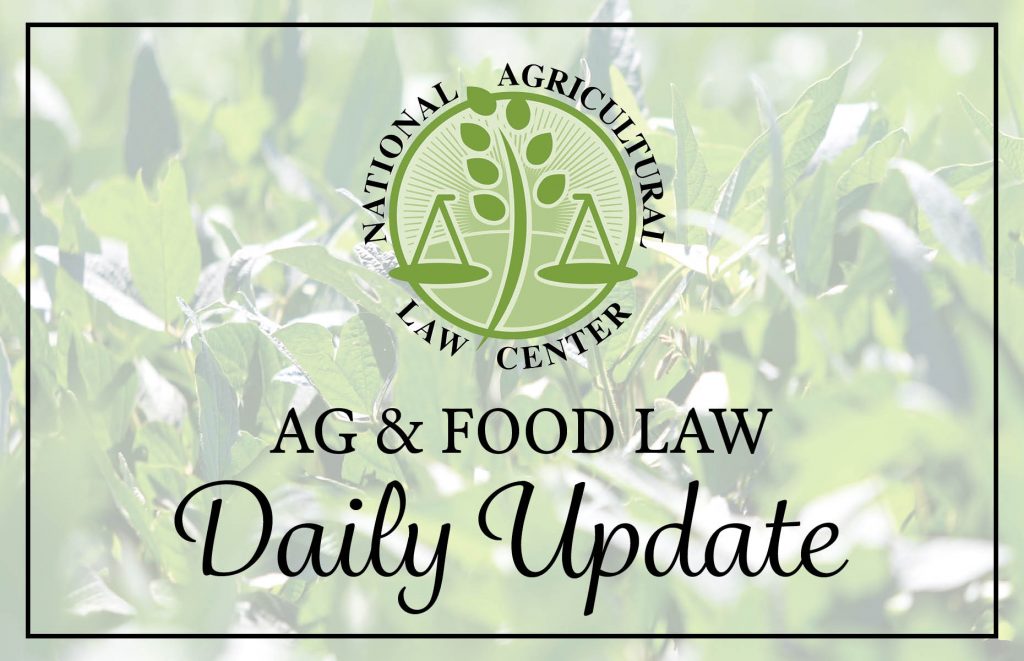A comprehensive summary of today’s judicial, legislative, and regulatory developments in agriculture and food. Email important additions HERE.
JUDICIAL: Includes CWA
In Blue Water Baltimore v. Wheeler, No. 16-452 (RBW), 2019 WL 6464974 (D. D.C. Dec. 2, 2019), the court considered a challenge to the Environmental Protection Agency’s (“EPA”) approval of Maryland’s Final 2018 Integrated Report of Surface Water Quality (“2018 Integrated Report”). The report was filed pursuant to the Clean Water Act (“CWA”) which requires that each state file a report with EPA identifying waters located within the state’s jurisdiction that are considered “impaired waters,” meaning that are so polluted, they can no longer be safely used. Along with the list of impaired waters, each state must also submit to EPA the total maximum daily load (“TMDL”) that the state plans to establish to reduce the amount of pollution present in the waterbody. States must submit this report to EPA for its approval every two years.
At issue in this case, is Maryland’s decision not to establish TMDLs for 139 impaired waterbodies in its 2012, 2014, 2016, and 2018 Integrated Reports. In each of those reports, Maryland listed the same 139 waterbodies as Category 4a, which are impaired waters that do not require a TMDL because one has already been established. The 139 waterbodies were part of the Chesapeake Bay watershed and are governed by the Chesapeake Bay TMDL which was finalized by EPA in 2010. However, plaintiffs argue that was a violation of the CWA for EPA to approve Maryland’s decision to list the 139 waterbodies as Category 4a when the plaintiffs believed that the correct designation for the waterbodies was Category 5, impaired waters that required TMDLs to be established. First, he plaintiffs argued that the text of the CWA specifically mandates states to establish TMDLs for all waterbodies listed as impaired, regardless of whether EPA has established a TMDL at the federal level. The court disagreed, concluding that such an interpretation of the CWA would place an additional obligation on the states that is not imposed by the CWA. According to the court, if EPA had established a TMDL for a waterbody, then it was reasonable that the state in which the waterbody was located was not required by the CWA to establish an additional TMDL. Second, the plaintiffs argued that the Chesapeake Bay TMDL failed to address the localized impairments in Maryland’s waterbodies. According to the court, this argument was not supported by the record which instead showed that both Maryland and the EPA had concluded that Maryland’s localized impairments were being appropriately addressed by the Chesapeake Bay TMDL. Because the court disagreed with both of the plaintiffs’ arguments, it found in favor of the defendants and granted their motion for summary judgment.
REGULATORY: Includes EPA
ENVIRONMENTAL PROTECTION AGENCY
Advance notice of proposed rulemaking soliciting information from the public as EPA considers proposing a future rule on adding certain per- and polyfluoroalkyl substances (“PFAS”) to the list of toxic chemicals subject to reporting under the Emergency Planning and Community Right-to-Know Act and the Pollution Prevention Act. Info here.
STATUTORY: Includes New York
NEW YORK
SB 4802 requires the commissioner of agriculture and markets to identify and develop standards for therapy dogs. Info here.
